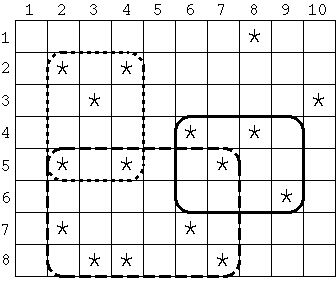求果园中在t*s的矩阵里最多能有几棵柿子树 二维树状数组模板题 poj 2029 Get Many Persimmon Trees
来源:互联网 发布:类似于知乎的网站 编辑:程序博客网 时间:2024/04/29 19:09
http://poj.org/problem?id=2029
Get Many Persimmon Trees
Time Limit: 1000MS Memory Limit: 30000KTotal Submissions: 3937 Accepted: 2563
Description
Seiji Hayashi had been a professor of the Nisshinkan Samurai School in the domain of Aizu for a long time in the 18th century. In order to reward him for his meritorious career in education, Katanobu Matsudaira, the lord of the domain of Aizu, had decided to grant him a rectangular estate within a large field in the Aizu Basin. Although the size (width and height) of the estate was strictly specified by the lord, he was allowed to choose any location for the estate in the field. Inside the field which had also a rectangular shape, many Japanese persimmon trees, whose fruit was one of the famous products of the Aizu region known as 'Mishirazu Persimmon', were planted. Since persimmon was Hayashi's favorite fruit, he wanted to have as many persimmon trees as possible in the estate given by the lord.
For example, in Figure 1, the entire field is a rectangular grid whose width and height are 10 and 8 respectively. Each asterisk (*) represents a place of a persimmon tree. If the specified width and height of the estate are 4 and 3 respectively, the area surrounded by the solid line contains the most persimmon trees. Similarly, if the estate's width is 6 and its height is 4, the area surrounded by the dashed line has the most, and if the estate's width and height are 3 and 4 respectively, the area surrounded by the dotted line contains the most persimmon trees. Note that the width and height cannot be swapped; the sizes 4 by 3 and 3 by 4 are different, as shown in Figure 1.

Figure 1: Examples of Rectangular Estates
Your task is to find the estate of a given size (width and height) that contains the largest number of persimmon trees.
For example, in Figure 1, the entire field is a rectangular grid whose width and height are 10 and 8 respectively. Each asterisk (*) represents a place of a persimmon tree. If the specified width and height of the estate are 4 and 3 respectively, the area surrounded by the solid line contains the most persimmon trees. Similarly, if the estate's width is 6 and its height is 4, the area surrounded by the dashed line has the most, and if the estate's width and height are 3 and 4 respectively, the area surrounded by the dotted line contains the most persimmon trees. Note that the width and height cannot be swapped; the sizes 4 by 3 and 3 by 4 are different, as shown in Figure 1.

Figure 1: Examples of Rectangular Estates
Your task is to find the estate of a given size (width and height) that contains the largest number of persimmon trees.
Input
The input consists of multiple data sets. Each data set is given in the following format.
N
W H
x1 y1
x2 y2
...
xN yN
S T
N is the number of persimmon trees, which is a positive integer less than 500. W and H are the width and the height of the entire field respectively. You can assume that both W and H are positive integers whose values are less than 100. For each i (1 <= i <= N), xi and yi are coordinates of the i-th persimmon tree in the grid. Note that the origin of each coordinate is 1. You can assume that 1 <= xi <= W and 1 <= yi <= H, and no two trees have the same positions. But you should not assume that the persimmon trees are sorted in some order according to their positions. Lastly, S and T are positive integers of the width and height respectively of the estate given by the lord. You can also assume that 1 <= S <= W and 1 <= T <= H.
The end of the input is indicated by a line that solely contains a zero.
N
W H
x1 y1
x2 y2
...
xN yN
S T
N is the number of persimmon trees, which is a positive integer less than 500. W and H are the width and the height of the entire field respectively. You can assume that both W and H are positive integers whose values are less than 100. For each i (1 <= i <= N), xi and yi are coordinates of the i-th persimmon tree in the grid. Note that the origin of each coordinate is 1. You can assume that 1 <= xi <= W and 1 <= yi <= H, and no two trees have the same positions. But you should not assume that the persimmon trees are sorted in some order according to their positions. Lastly, S and T are positive integers of the width and height respectively of the estate given by the lord. You can also assume that 1 <= S <= W and 1 <= T <= H.
The end of the input is indicated by a line that solely contains a zero.
Output
For each data set, you are requested to print one line containing the maximum possible number of persimmon trees that can be included in an estate of the given size.
Sample Input
1610 82 22 52 73 33 84 24 54 86 46 77 57 88 18 49 610 34 386 41 22 12 43 44 25 36 16 23 20
Sample Output
43
Source
Japan 2003 Domestic
思路: 简单的二维树状数组
分析:1 题目给定一个人h*w的矩阵,给定n个点表示该点上面有柿子树,求给定一个t*s的矩阵的最多的柿子树的个数
2 简单的二维树状数组,加入一个点的时候更新树状数组
3 题目的范围最大为100,很明显就是要暴力枚举起点,然后求最大值即可
代码:
#include<cstdio>#include<cstring>#include<iostream>#include<algorithm>using namespace std;const int MAXN = 110;int n , w , h;int treeNum[MAXN][MAXN];int lowbit(int x){ return x&(-x);}void add(int x , int y , int val){ for(int i = x ; i < MAXN ; i += lowbit(i)) for(int j = y ; j < MAXN ; j += lowbit(j)) treeNum[i][j] += val;}int getSum(int x , int y){ int sum = 0; for(int i = x ; i > 0 ; i -= lowbit(i)) for(int j = y ; j > 0 ; j -= lowbit(j)) sum += treeNum[i][j]; return sum;}int solve(int x , int y){ int ans = 0; for(int i = 1 ; i <= h ; i++){ for(int j = 1 ; j <= w ; j++){ int sum = getSum(i+x-1 , j+y-1); sum -= getSum(i-1 , j+y-1); sum -= getSum(i+x-1 , j-1); sum += getSum(i-1 , j-1); ans = max(ans , sum); } } return ans;}int main(){ int x , y; while(scanf("%d" , &n) && n){ scanf("%d%d" , &w , &h); memset(treeNum , 0 , sizeof(treeNum)); for(int i = 0 ; i < n ; i++){ scanf("%d%d" , &x , &y); add(y , x , 1); } scanf("%d%d" , &x , &y); printf("%d\n" , solve(y , x)); } return 0;} 0 0
- 求果园中在t*s的矩阵里最多能有几棵柿子树 二维树状数组模板题 poj 2029 Get Many Persimmon Trees
- poj 2029 Get Many Persimmon Trees 二维树状数组
- POJ 2029 Get Many Persimmon Trees(二维树状数组)
- POJ 2029 Get Many Persimmon Trees 二维树状数组
- poj 2029 Get Many Persimmon Trees 二维树状数组 大水
- poj 2029 Get Many Persimmon Trees(二维树状数组)
- poj 2029 Get Many Persimmon Trees (二维树状数组)
- Poj 2029 Get Many Persimmon Trees 二维树状数组
- POJ 2029 Get Many Persimmon Trees (二维树状数组)
- poj 2029 Get Many Persimmon Trees 二维树状数组
- poj 2029 Get Many Persimmon Trees 【二维树状数组】
- POJ 2029 Get Many Persimmon Trees(二维树状数组)
- (POJ 2029)Get Many Persimmon Trees <二维树状数组>
- poj 2029 Get Many Persimmon Trees 二维树状数组
- 【树状数组--二维】poj 2029 Get Many Persimmon Trees
- [树状数组] poj 2029 Get Many Persimmon Trees#裸的二维树状数组
- POJ 2029 Get Many Persimmon Trees DP/二维树状数组/线段树
- POJ 2029 Get Many Persimmon Trees 二维树状数组(水)
- 学习JS(7)
- strstr函数的自己实现
- 6天通吃树结构—— 第五天 Trie树
- 复制DataTable时出现"该行已经属于另一个表"异常的解决办法
- 网站搭建过程中后台相关 随笔
- 求果园中在t*s的矩阵里最多能有几棵柿子树 二维树状数组模板题 poj 2029 Get Many Persimmon Trees
- 移动端购物车的实现
- 数字处理类
- 谢尔排序
- leetcode 214: Shortest Palindrome
- [Java Concurrency in Practice]第七章 取消与关闭
- Android RadioButton
- OSPF特殊区域之STUB
- swift - The Flyweight Pattern


